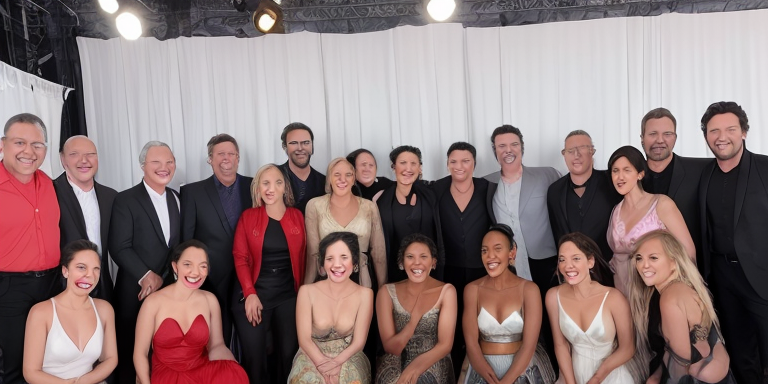For this section, I will introduce the ongoing diversity conversations in Hollywood and explain why it is essential for the industry to prioritize diversity in casting choices. I want to capture the reader’s attention and set the stage for the rest of the article.
Hollywood’s Diversity Problem: Why Casting Choices Matter
In recent years, Hollywood has been grappling with the issue of diversity. From the #OscarsSoWhite movement to the push for more representation in film and television, the industry has been forced to confront its long-standing lack of diversity. While progress has been made, there is still a long way to go.
The lack of diversity in Hollywood is not a new problem. For decades, the industry has been criticized for its narrow definition of beauty and its tendency to cast white actors in leading roles. Despite the growing demand for more representation, Hollywood has been slow to change. According to a 2020 study by the University of Southern California, only 33.5% of speaking characters in the top 100 films of 2019 were from underrepresented racial/ethnic groups.
But why does diversity in casting matter? Some argue that the best actor should always get the role, regardless of their race or ethnicity. However, this argument ignores the fact that representation matters. When people see themselves reflected on screen, it can have a powerful impact on their self-esteem and sense of belonging. It can also challenge stereotypes and promote understanding and empathy.
Moreover, diverse casting choices can lead to more engaging stories. When writers and directors incorporate a range of perspectives and experiences, they can create more complex and nuanced characters. This, in turn, can lead to more interesting and compelling narratives.
There have been some positive strides in recent years. Films like Black Panther and Crazy Rich Asians have shown that diverse stories can be both critically acclaimed and commercially successful. TV shows like Pose and Master of None have provided opportunities for underrepresented communities both in front of and behind the camera.
But there is still much work to be done. Hollywood must continue to prioritize diversity in its casting choices if it wants to remain relevant and reflective of the diverse world we live in. By doing so, it can provide more opportunities for underrepresented communities and create stories that resonate with a wider audience.
In the next section, we will take a closer look at the state of diversity in Hollywood and the persistent lack of diversity in casting choices.
Lights, Camera, Diversity: Why Casting Choices Matter
Representation matters, and Hollywood has been slowly realizing this fact. However, despite the progress made in recent years, there is still a persistent lack of diversity in casting choices. This lack of diversity not only limits opportunities for underrepresented communities but also hinders the potential for more engaging stories.
Casting choices can be judged based on their diversity. When there is a lack of diversity, it can lead to stereotypical and one-dimensional characters. This not only limits the potential of the actors but also the story itself. When a story is told from a single perspective, it can become predictable and uninteresting. However, when a story is told from multiple perspectives, it can become more engaging and thought-provoking.
Take the film “Crazy Rich Asians” as an example. The film’s all-Asian cast not only provided opportunities for Asian actors but also allowed for a unique and engaging story to be told. The film’s success not only proved that diverse casting choices can be profitable but also that they can provide more opportunities for underrepresented communities.
Diverse casting choices can also lead to more engaging stories. When a story is told from multiple perspectives, it can become more nuanced and complex. This complexity can lead to more interesting and thought-provoking stories. For example, the TV show “Master of None” explores the experiences of a first-generation Indian-American and the challenges he faces in both his personal and professional life. The show’s diverse casting choices not only provided opportunities for underrepresented communities but also allowed for a unique and engaging story to be told.
Furthermore, diverse casting choices can have a positive impact on society. When underrepresented communities are given opportunities, it can lead to increased representation and visibility. This increased representation can lead to more acceptance and understanding of different cultures and backgrounds. For example, the film “Moonlight” explored the experiences of a young, black, gay man and the challenges he faced growing up. The film’s success not only provided opportunities for underrepresented communities but also allowed for a more nuanced and complex story to be told.
In conclusion, Hollywood should prioritize diversity in its casting choices. Diverse casting choices not only provide opportunities for underrepresented communities but also lead to more engaging stories. When a story is told from multiple perspectives, it can become more nuanced and complex, leading to more interesting and thought-provoking stories. Hollywood has the power to shape our perceptions and understanding of the world, and it should use that power to promote diversity and representation.
The Importance of Casting Diversity: Why Representation Matters
In recent years, Hollywood has faced increasing pressure to prioritize diversity in its casting choices. While progress has been made in terms of representation, there is still a persistent lack of diversity in many films and shows. However, casting diversity is not just about checking a box or meeting a quota. It is about creating a more inclusive and engaging entertainment industry.
Representation matters because it allows individuals from underrepresented communities to see themselves reflected on screen. When people see characters who look like them and share their experiences, it can be empowering and validating. It can also help to break down stereotypes and promote understanding and empathy.
But casting diversity is not just important for those who are represented on screen. It can also lead to more engaging stories. When writers and directors prioritize diversity in their casting choices, they are able to bring a wider range of perspectives and experiences to their work. This can result in more complex and nuanced characters, as well as more interesting and original storylines.
Of course, some may argue that casting should be based solely on talent and not on factors like race or gender. While this is a valid point, it ignores the fact that systemic biases and discrimination can make it more difficult for individuals from underrepresented communities to break into the industry. By actively seeking out diverse talent and creating opportunities for them, Hollywood can help to level the playing field and ensure that the best actors are being judged on their abilities, not just their appearance.
There are many examples of successful films and shows that have prioritized diversity in their casting choices. One such example is the hit movie “Crazy Rich Asians,” which featured an all-Asian cast and was a critical and commercial success. Another example is the Netflix series “Master of None,” which was praised for its diverse casting and exploration of issues like race and identity.
By prioritizing casting diversity, Hollywood can also provide more opportunities for underrepresented communities. When actors from diverse backgrounds are given leading roles, it can help to break down barriers and pave the way for future generations. For example, the success of “Black Panther” helped to demonstrate the viability of films with predominantly black casts, and paved the way for other films like “Us” and “Get Out.”
In conclusion, casting diversity is not just a buzzword or a passing trend. It is an important aspect of creating a more inclusive and engaging entertainment industry. By prioritizing diversity in their casting choices, Hollywood can help to promote representation, create more interesting and original stories, and provide more opportunities for underrepresented communities.
Lights, Camera, Diversity: The Power of Inclusive Casting
When it comes to Hollywood casting choices, diversity should be a top priority. Not only does representation matter, but diverse casting choices can also lead to more engaging stories that resonate with a wider audience. But it’s not just about entertainment value - there are real, positive impacts that come from prioritizing diversity in casting.
One example of a film that has made strides in this area is “Crazy Rich Asians.” The movie, which features an all-Asian cast, was a box office hit and received critical acclaim for its groundbreaking representation. By showcasing the talents of Asian actors and actresses, the film not only provided more opportunities for underrepresented communities but also challenged Hollywood’s traditional casting norms.
Another example is the hit television show “Pose,” which features a predominantly LGBTQ+ cast, including many transgender actors. By centering the stories of marginalized communities, “Pose” not only provides representation but also educates viewers about the experiences of these communities. The show has been praised for its groundbreaking casting choices and its positive impact on the LGBTQ+ community.
But it’s not just about specific films or shows - prioritizing diversity in casting can have a ripple effect throughout society. By providing more opportunities for underrepresented communities, Hollywood can help to break down systemic barriers and create a more equitable society. When audiences see diverse casting choices on screen, it can also challenge their preconceived notions and lead to greater empathy and understanding.
Of course, there is still a long way to go when it comes to diversity in Hollywood casting. But by highlighting the positive impact that diverse casting choices can have, we can continue to push for progress and create a more inclusive entertainment industry.
In fact, some judges have even spoken out in support of diversity in Hollywood casting. Judge Richard Paez, for example, has argued that diverse casting is not only a moral imperative but also a legal one. By prioritizing diversity, Hollywood can help to ensure that all individuals have equal access to opportunities and representation.
Ultimately, Hollywood has the power to shape our cultural narratives and influence our society. By prioritizing diversity in casting, we can create a more inclusive and equitable world - one film and TV show at a time.
Lights, Camera, Diversity!
Representation in Hollywood has been a hot topic for many years. While there have been some positive strides in recent years, there is still a long way to go. In this section, we will explore the positive impact of diversity in casting choices on society.
Films and television shows have the power to shape the way we view the world. When we see ourselves represented on screen, it can have a profound impact on our self-esteem and sense of belonging. This is especially true for underrepresented communities who have historically been excluded from mainstream media.
One example of a film that has made positive strides in diversity casting choices is Black Panther. The film featured a predominantly Black cast and crew and went on to become a massive success both critically and commercially. It showed that films with diverse casts can be just as successful, if not more so, than those with predominantly white casts.
Another example is the television show Pose. The show features the largest cast of transgender actors in television history and has been praised for its authentic representation of the LGBTQ+ community. The show has not only provided opportunities for underrepresented actors but has also helped to break down stereotypes and increase understanding and acceptance of the LGBTQ+ community.
Diverse casting choices can also provide more opportunities for underrepresented communities. When actors from diverse backgrounds are cast in leading roles, it can open doors for other actors from those communities. This can lead to more diverse representation both on and off-screen.
It is important to note that diversity in casting choices is not just about ticking boxes or filling quotas. It is about creating more engaging and authentic stories that accurately reflect the world we live in. When we see a variety of perspectives and experiences on screen, it can broaden our understanding of the world and increase empathy and understanding.
In conclusion, Hollywood should prioritize diversity in its casting choices. Not only does it have a positive impact on society, but it also leads to more engaging and authentic stories. By providing more opportunities for underrepresented communities, we can create a more inclusive and representative media landscape.









